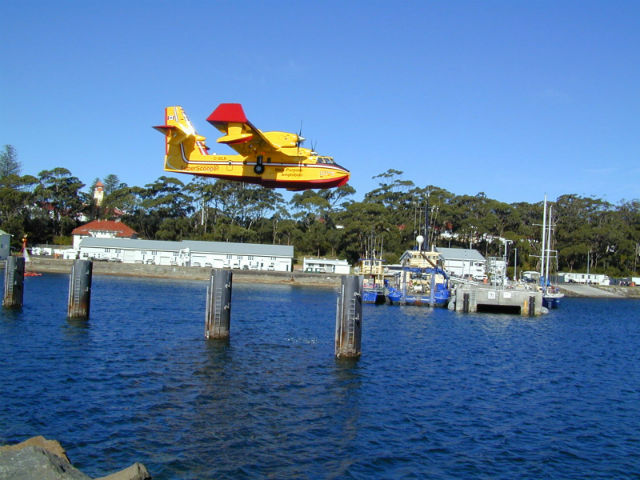EAA AirVenture in Oshkosh can always be relied upon to showcase some dreams, and Icon's A5 amphibian looks set – finally – to become a dream come true. But what about other land-or-sea flyers? We survey in-production and on-the-cusp types, and one magnificent vision.
1. Icon A5
The two-seat A5 was unveiled in 2008 and Icon planned to deliver the first production version of the light sport aircraft two years later – but not so fast. Six years on came the first production-conforming prototype, and service entry is now slated for May 2016, followed by production ramp-up to “hundreds” annually, to meet demand indicated by nearly 1,300 order deposits.
![]()
Icon A5
Icon Aircraft
2. AVIC AG600
According to the Want China Times, assembly is under way in Zhuhai of the “world's largest amphibious aircraft” in a bid to make a maiden flight next year. Designed for sea rescue and fire-fighting with a maximum take-off weight of over 50t, the AG600 is said to be able to rescue 50 people at once - which might be a good thing, indeed, given China’s recent maritime safety record and highly disputed territorial ambitions in the South China Sea.

AVIC AG600
Want China Times/Xinhua
3. Lisa Akoya
Another amphibian with 2016 service-entry hopes is the Akoya, from Lisa Airplanes. The company has been flying two test aircraft at its base in Le Bourget-du-Lac, southeast France, and is believed to have secured about 100 deposits for the two-seater, mostly from America. The Akoya programme was originally slated for certification in 2015, but when funding dried up in 2012 in the wake of the financial meltdown privately-owned Lisa was forced into receivership.

Lisa Akoya
Lisa Airplanes
4. ShinMaywa US-2
The Japanese type made the news back in April, when an example operated by the Japan Maritime Self Defence Force was involved in a major accident off the coast of the nation’s Kochi province, leaving it floating nose down in the sea, its fuselage perpendicular to the waves. All 19 aboard were reportedly rescued, but four injured.

ShinMaywa US-2
Japan Maritime Self Defence Force
5. Beriev Be-200
The Russian manufacturer restarted serial production of its amphibian twinjet in 2013, with the initial example set to roll off the production line in 2013, on the strength of a dozen orders from Russia’s emergencies and defence ministries. The Be-200 is a real beast, able to carry up to 12t of water in firefighting mode, or 72 passengers.

Be-200 at MAKS 2009
Vlsergey/wikimedia commons
6. Bombardier CL-415
The 415 traces its roots to the Canadair CL-215, which first flew in 1967, and is the third iteration in this venerable line of amphibians. Nicknamed the “Superscooper”, the type features two water tanks, each holding 3,655 litres (966USgal). The probes that suck up all this liquid are, contrary to urban myth, much too small to ingest a scuba diver.

CL-415
Bombardier
7. Searey Elite, Sport, LSX
Available factory-built or in kit form, Searey’s high wing, pusher, tail dragger two-seaters are direct competition for the Icon A5.

Searey Elite
Searey
8. SeaMax SeaMaster M-22
Another light sport amphibian, from Brazil.

SeaMaster M-22
MKFI/wikimedia commons
9. And now for something really amazing!
Not a production aircraft and a straight seaplane rather than an amphbian, but oh-so-worth-a-mention is this wonderful idea from the aeronautics department at Imperial College in London. Dr Errikos Levis reckons his concept for a blended wing body medium- to long-range seaplane could be just the answer where more runway space is needed:
“For many people the majestic seaplanes of the 1940s evoke a more romantic era in aviation history. However, when it came to efficiency and the sheer volume of people that they needed to carry, these planes couldn’t compete with the newer passenger aircraft coming on to the market in the 1950s and they quickly lost their appeal. In the 21st Century, the aviation industry is facing new challenges and we wanted to show a radical approach to the constraints on land-cased airports, and look at how advanced seaplanes, using today’s technology, could once again become an alternative mode of travel for long-haul flights.”
Don’t expect to see them flying soon, but don’t dismiss the idea as a flight of fancy. Such a machine could be big enough to accommodate the tanks for hydrogen fuel – and carry 2,000 passengers.

2,000 passengers, on final approach...
Imperial College
Source: FlightGlobal.com



















